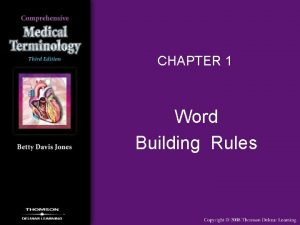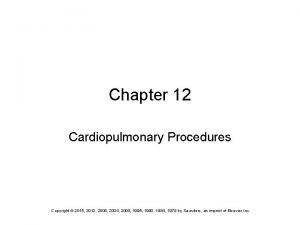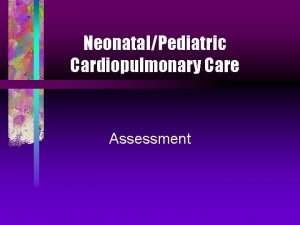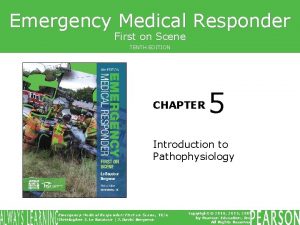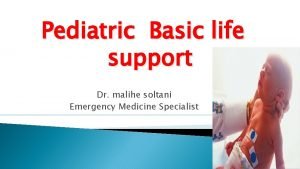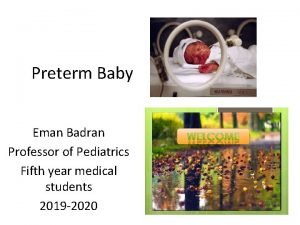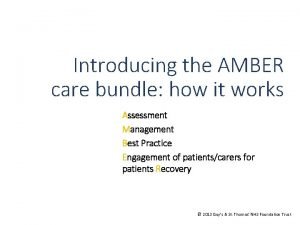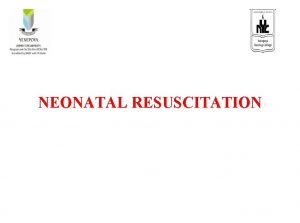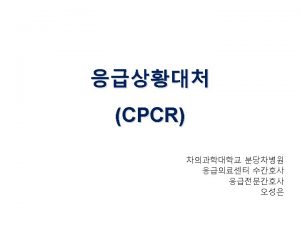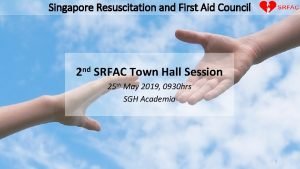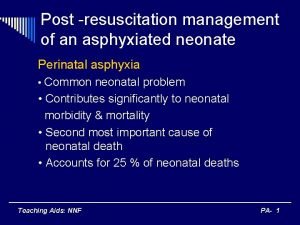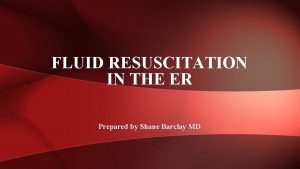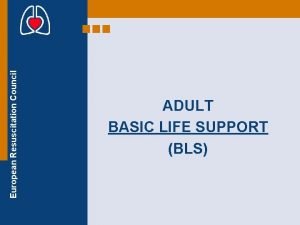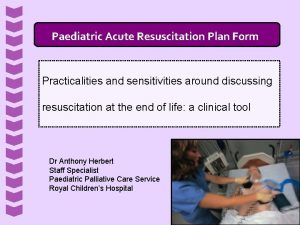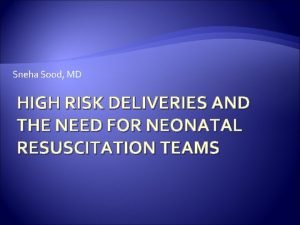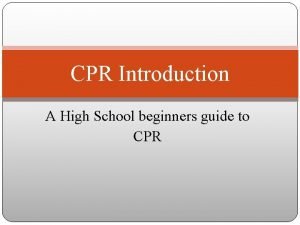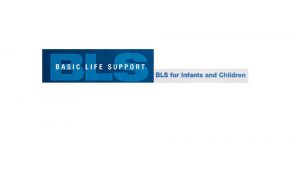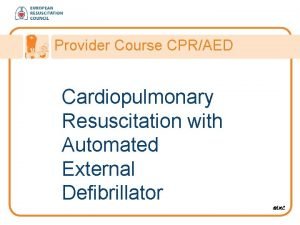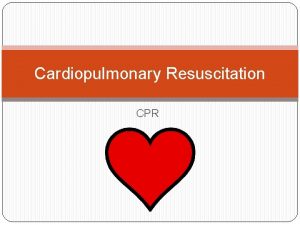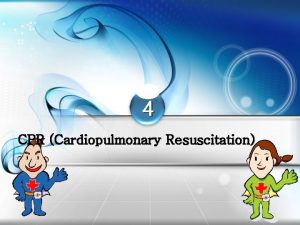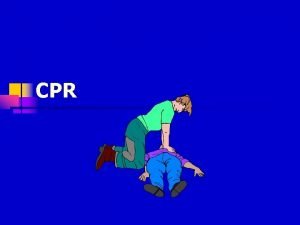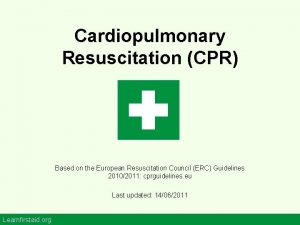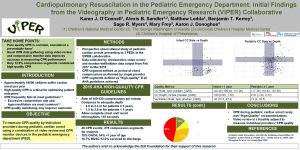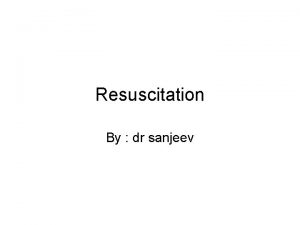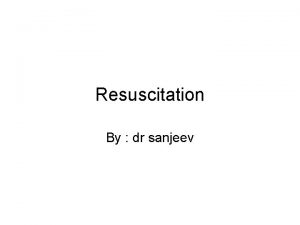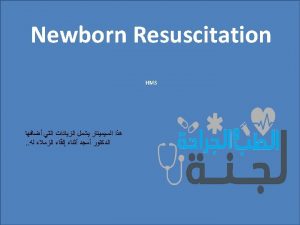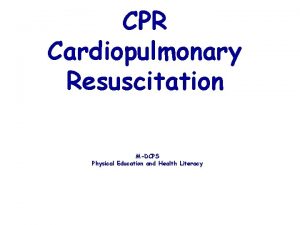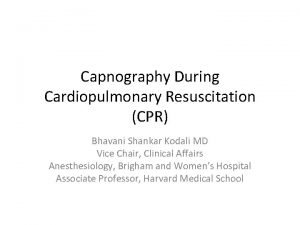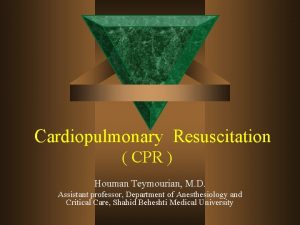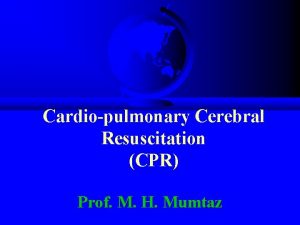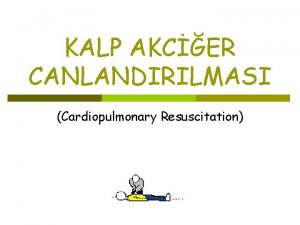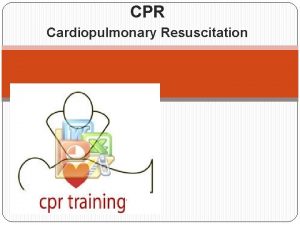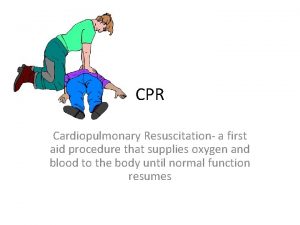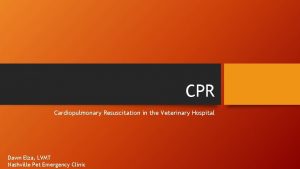Pediatric Cardiopulmonary resuscitation CPR It is an emergency































- Slides: 31

Pediatric


Cardiopulmonary resuscitation (CPR): - It is an emergency procedures which is performed on person suffering cardiac or respiratory arrest. -It is a combination of rescue breathing (mouth-to-mouth resuscitation) and chest compressions. CPR can restore circulation of oxygen-rich blood to the brain.

-The commonest cause of cardiopulmonary arrest in pediatric is respiratory.

Change in CPR Sequence: C-A-B Rather Than A-B-C

2010 (NEW): A CHANGE IN THE 2010 AHA GUIDELINES FOR CPR AND ECC IS TO RECOMMEND THE INITIATION OF CHEST COMPRESSIONS BEFORE VENTILATIONS. 2005 (OLD): THE SEQUENCE OF ADULT CPR BEGAN WITH OPENING OF THE AIRWAY, CHECKING FOR NORMAL BREATHING, AND THEN DELIVERING 2 RESCUE BREATHS FOLLOWED BY CYCLES OF 30 CHEST COMPRESSIONS AND 2 BREATHS.

CPR 2010

-Cardiopulmonary resuscitation (CPR) is a series of lifesaving actions that improve the chance of survival following cardiac arrest.

The 2010 AHA Guidelines for CPR and ECC recommend CAB sequence. (chest compressions- airway- breathing)

-Most cardiac arrests in adults are resulting from a primary cardiac cause (e. g: VF) the chest compressions are more important than ventilations. - Cardiac arrest in children is most often asphyxial, which requires both ventilations and chest compressions for optimal results.

-Starting CPR with 30 compressions followed by 2 ventilations should theoretically delay ventilations by only about 18 seconds for the lone rescuer and by an even a shorter interval for 2 rescuers. -The CAB sequence for infants and children is recommended in order to simplify training with the hope that more victims of sudden cardiac arrest will receive bystander CPR.

Pediatric Chain of Survival 2010

BLS Sequence for Lay Rescuers : These guidelines delineate a series of skills as a sequence of distinct steps depicted in the Pediatric BLS: �Safety of Rescuer and Victim: Always make sure that the area is safe for you and the victim.

�Assess Need for CPR: To assess the need for CPR, the lay rescuer should assume that cardiac arrest is present if the victim is unresponsive and not breathing or only gasping.

�Check for Response: - Gently tap the victim and ask loudly, If the child is responsive, he or she will answer or move. Quickly check to see if the child has any injuries or needs medical assistance. - If you are alone and the child is breathing, leave the child to phone the emergency response system, but return quickly and recheck the child's condition frequently. - Children with respiratory distress often assume a position that maintains airway patency and optimizes ventilation.

� Check for Breathing: - - If you see regular breathing, the victim does not need CPR. he victim is unresponsive and not breathing (or only gasping), begin CPR.

�Start Chest Compressions (C) : During cardiac arrest, high-quality chest compressions generate blood flow to vital organs. -If the infant or child is unresponsive and not breathing, give 30 chest compressions.

-The following are characteristics of high-quality CPR: o Chest compressions of appropriate rate and depth. "Push fast": push at a rate of at least 100 compressions per minute. "Push hard": push with sufficient force to depress at least one third the anterior-posterior (AP) diameter of the chest or approximately 1 inches (4 cm) in infants and 2 inches (5 cm) in children. o Allow complete chest recoil after each compression to allow the heart to refill with blood. o Minimize interruptions of chest compressions.

- For best results, chest compressions on a firm surface. an infant, lone rescuers, should compress the sternum with 2 fingers, placed just below the intermammary line. Do not compress over the xiphoid or ribs.

Two-finger chest compression technique in infant (1 rescuer).

wo thumb-encircling hands chest compression in infant (2 rescuers)

- For a child, lay rescuers should compress the lower half of the sternum at least one third of the AP dimension of the chest or approximately 5 cm (2 inches) with the heel of 1 or 2 hands. Do not press on the xiphoid or the ribs. - After each compression, allow the chest to recoil completely. because complete chest re-expansion improves the flow of blood returning to the heart.

�Open the Airway and Give Ventilations(A – B): -For the lone rescuer a compression-toventilation ratio of 30: 2 is recommended. After the initial set of 30 compressions, open the airway and give 2 breaths. -In an unresponsive infant or child, the tongue may obstruct the airway and interfere with ventilations, open the airway using a head tilt –chin lift maneuver.


- To give breaths to an infant, use a mouth to mouth and nose technique. - To give breaths to a child, use a mouth-tomouth technique. Make sure the breaths are effective (i. e. the chest rises). Each breath should take about 1 second. If the chest does not rise, reposition the head, make a better seal and try again.

�Coordinate Chest Compressions and Breathing: -After giving 2 breaths, immediately give 30 compressions. The lone rescuer should continue this cycle of 30 compressions and 2 breaths for approximately 2 minutes before leaving the victim to activate the emergency response system and obtain an automated external defibrillator (AED). -Ratio of compression : ventilation 30: 2 for one rescue, and 15: 2 for 2 rescue.

�Activate Emergency Response System: - -If there are 2 rescuers, one should start CPR immediately and the other should activate the emergency response system and obtain an AED, if one is available. -Most infants and children with cardiac arrest have an asphyxial rather than a VF arrest; therefore 2 minutes of CPR are recommended before the lone rescuer activates the emergency response system. The lone rescuer should then return to the victim as soon as possible and use the AED (if available) or resume CPR.


BLS Sequence for Healthcare Providers: For the most part the sequence of BLS for healthcare providers is similar to that for laypeople (one rescue) with some variation as indicated below. Healthcare providers are more likely to work in teams.


Thank you
 Chapter 17 1 providing first aid
Chapter 17 1 providing first aid Resuscitation cpr
Resuscitation cpr Cpr definition medical
Cpr definition medical Broselow tape
Broselow tape Cardiopulmonary word breakdown
Cardiopulmonary word breakdown Crossword puzzle cardiopulmonary procedures
Crossword puzzle cardiopulmonary procedures Pulmonary circulation system
Pulmonary circulation system Cardiopulmonary
Cardiopulmonary Emergency medical responder first on scene 10th edition
Emergency medical responder first on scene 10th edition Pediatric emergency life support
Pediatric emergency life support Difference between resuscitation and resurrection
Difference between resuscitation and resurrection Preterm classification
Preterm classification Amber care
Amber care Indication of bed bath
Indication of bed bath Resuscitation triangle roles
Resuscitation triangle roles European resuscitation council
European resuscitation council Bcls singapore pdf
Bcls singapore pdf Management of asphyxia neonatorum after resuscitation
Management of asphyxia neonatorum after resuscitation Endpoint of resuscitation
Endpoint of resuscitation Fluid resuscitation formula
Fluid resuscitation formula European resuscitation council
European resuscitation council Acute resuscitation plan form
Acute resuscitation plan form Neonatal resuscitation definition
Neonatal resuscitation definition Principle of resuscitation
Principle of resuscitation Dr sneha sood
Dr sneha sood Dope neonatal resuscitation
Dope neonatal resuscitation Cardioprotection resuscitation
Cardioprotection resuscitation European resuscitation council
European resuscitation council Cpr bydgoszcz
Cpr bydgoszcz For adult
For adult Cpr learning objectives
Cpr learning objectives Hand position for cpr
Hand position for cpr




